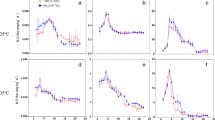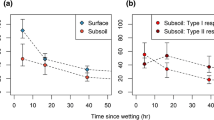Abstract
Production and sources of N2O were determined in soil columns amended with autoclaved yeast cells either mixed into or added as 0.5 cm3 lumps to the soil in combination with no or 200 μg NO¯ 3-N g−1. At four occasions over a two-week study period, subsets of cores were measured for N2O production during 4-hour incubations under atmospheres of ambient air, 10 Pa of C2H2, and N2, respectively. Denitrification enzyme activity (DEA) was assessed in subsamples of cores that had been incubated continuously under air.
Autoclaved yeast provided a C-source readily available for denitrifying bacteria in the soil. Nitrous oxide production was negligible in unamended columns whereas accumulated N2O losses in the presence of yeast material were substantial, varying between 15 to 49 ng N2O-N g−1 h−1. Mixing yeast into the soil caused the highest production of N2O followed by the yeast lump and no yeast treatments. Incubation in the presence of 10 Pa C2H2 indicated that denitrification was the sole source of N2O, in accordance with an increase in DEA. Nitrous oxide production and DEA peaked after 4–7 days of incubation, and both were unaffected by additional NO¯ 3. Two-to four-fold responses to anaerobiosis and accumulation of NO¯ 3 and NH4+ 4 in proximity of the lumps indicated that N2O production here was limited by relatively low C-availability. In contrast, 10- to 12-fold responses to anaerobiosis and no accumulation of inorganic N suggested a higher C-availability where yeast was mixed into the soil.
Access this chapter
Tax calculation will be finalised at checkout
Purchases are for personal use only
Preview
Unable to display preview. Download preview PDF.
Similar content being viewed by others
References
Anderson I C, Poth M, Homstead J and Burdige D 1993 A comparison of NO and N2O production by the autotrophic nitrifier Nitrosomonas europaea and the heterotrophic nitrifier Alcaligenes faecalis. Appl. Environ. Microbiol. 59, 3525–3533.
Aulakh M S, Doran J W, Walters DT, Mosier A R and Francis D D 1991 Crop residue type and placement effects on denitrification and mineralization. Soil Sci. Soc. Am. J. 55, 1020–1025.
Bergstrom D W, Tenuta M and Beauchamp E G 1994 Increase in nitrous oxide production in soil induced by ammonium and organic carbon. Biol. Fertil. Soils 18, 1–6.
Christensen S, Simkins S and Tiedje J M 1990 Temporal patterns of soil denitrification: their stability and causes. Soil Sci. Soc. Am. J. 54, 1614–1618.
Duxbury J M and McConnaughey P K 1986 Effect of fertilizer source on denitrification and nitrous oxide emissions in a maize-field. Soil Sci. Soc. Am. J. 50, 644–648.
Firestone M K, Smith M S, Firestone B and Tiedje J M 1979 The influence of nitrate, nitrite, and oxygen on the composition of the gaseous products of denitrification in soil. Soil Sci. Soc. Am. J. 43, 1140–1144.
Firestone M K and Davidson E A 1989 Microbiological basis of NO and N2O production and consumption in soil. In Exchange of trace Gases between Terrestrial Ecosystems and the Atmosphere. Eds. M O Andreae and D S Schimel. pp 7–21. John Wiley and Sons, Chichester, UK.
Goreau T J, Kaplan W A, Wofsy S C, McElroy M B, Valois F W and Watson S W 1980 Production of NO¯ 2 and N2O by nitrifying bacteria at reduced concentrations of oxygen. Appl. Environ. Microbiol. 40, 526–532.
Henriksen K and Larsen L 1991 Temporal and spatial variation in nitrification and denitrification activities in millimeter zones in and around organic hot spots. In Denitrification in Forest Soils — Summaries from a Workshop arranged in Copenhagen. Eds. P Ineson et al. Denmark 6–7 November 1989. EC, Brussels, Belgium.
Martin K, Parsons L L, Murray R E and Smith M S 1988 Dynamics of soil denitrifier populations: relationships between enzyme activity, most-probable number counts, and actual N gas loss. Appl. Environ. Microbiol. 54, 2711–2716.
McKenney D J, Wang S W, Drury C F and Findlay W I 1993 Denitrification and mineralization in soil amended with legume, grass, and corn residues. Soil Sci. Soc. Am. J. 57, 1013–1020.
Myrold D D and Tiedje J M 1985 Establishment of denitrification capacity in soil: effects of carbon, nitrate, and moisture. Soil. Biol. Biochem. 17, 819–822.
Parkin T B 1987 Soil microsites as a source of denitrification variability. Soil Sci. Soc. Am. J. 51, 1194–1199.
Poth M and Focht D D 1985 15N kinetic analysis of N2O production by Nitrosomonas europaea: an examination of nitrifier denitrification. Appl. Environ. Microbiol. 49, 1134–1141.
Rice C W, Sierzega P E, Tiedje J M and Jacobs L W 1988 Stimulated denitrification in the microenvironment of a biodegradable organic waste injected into soil. Soil Sci. Soc. Am. J. 52, 102–108.
Rolston D E, Sharpley A N, Toy D W and Broadbent F E 1982 Field measurements of denitrification: III. Rates during irrigation cycles. Soil Sci. Soc. Am. J. 46, 289–296.
Rudaz A O, Davidson E A and Firestone M K 1991 Sources of nitrous oxide production following wetting of dry soil. FEMS Microbiol. Ecol. 85, 117–124.
SAS 1990 SAS/STAT User’s guide, Version 6, Fourth Edition. SAS Institute, Cary, NC, USA.
Smith M S and Tiedje J M 1979 Phases of denitrification following oxygen depletion in soil. Soil. Biol. Biochem. 11, 261–267.
Tiedje J M 1988 Ecology of denitrification and dissimilatory nitrate reduction to ammonium. In Biology of Anaerobic Microorganisms. Ed. A J B Zehnder. pp 179–244. John Wiley and Sons, New York, USA.
Author information
Authors and Affiliations
Editor information
Rights and permissions
Copyright information
© 1996 Springer Science+Business Media Dordrecht
About this chapter
Cite this chapter
Ambus, P. (1996). Production of N2O in soil during decomposition of dead yeast cells with different spatial distributions. In: Van Cleemput, O., Hofman, G., Vermoesen, A. (eds) Progress in Nitrogen Cycling Studies. Developments in Plant and Soil Sciences, vol 68. Springer, Dordrecht. https://doi.org/10.1007/978-94-011-5450-5_81
Download citation
DOI: https://doi.org/10.1007/978-94-011-5450-5_81
Publisher Name: Springer, Dordrecht
Print ISBN: 978-94-010-6292-3
Online ISBN: 978-94-011-5450-5
eBook Packages: Springer Book Archive




